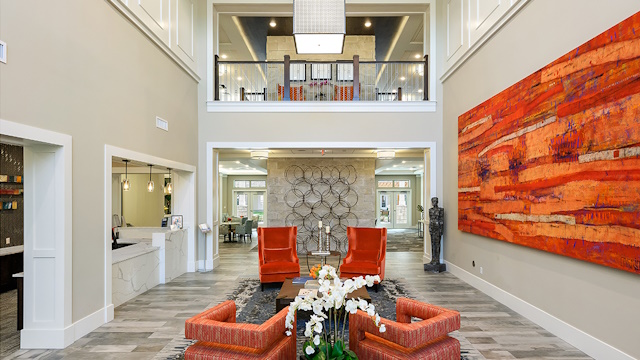Partner with an Innovative Architecture Firm Skilled in Senior Living Solutions
Senior living buildings provide homes for multiple residents (of different scales) under one roof, creating a unique sense of community. This feeling of belonging is influenced by the space’s architectural choices, functionality, and comfort. Creating communities that are worthy of a person’s next chapter in life can be a challenge, though. Even experienced architecture firms can struggle to develop a design that truly empowers, motivates, and inspires its residents and caregivers alike.
NSPJ Architects has made senior living communities one of our many specialties. We design spaces that are carefully proportioned and richly detailed. We’ve mastered the art of residential architecture for older adults and take a holistic approach that considers the best interests of those who live, work, and visit there, while promoting a sense of care and well-being to keep residents active.
Over the past few decades, a trend has emerged to make these facilities less “facility-like” by including the comforts of home. Nursing homes, in particular, were originally modeled after hospital wings, where dozens of beds occupied just a few rooms. Dinners happened on a set schedule, and residents were served pre-packaged meals. Since then, open-plan and resident-focused luxury senior living communities have grown in popularity. These spaces are filled with features and amenities that look and feel familiar, while still providing the safety, support, and care one needs in the later stages of life.
This concept shines through in our own work, as we believe individuals deserve to love where they live at every age. Keep reading to discover how thoughtful architecture can enhance senior living communities.
Architecture Can Increase Independence in Senior Living Communities
Older adults often move to senior living communities because they may wish to enjoy their lives without the entanglements of caring for the home or planned meal preparation. In addition, there are many that no longer can or want to live alone. A well-designed space can encourage independence. Seniors may feel trapped in their own home by obstacles like stairs or a poor layout. A senior living community can mitigate trips, falls, and other accidents by prioritizing safe and functional architecture. Here are just some of the ways this can be achieved:
- Minimizing steps: The less steps, the better when it comes to senior living communities. By keeping stairs to a minimum, residents have more freedom to move as they please and aren’t confined to their individual living space. Those who use wheelchairs and walkers won’t have to worry about putting themselves in an unsafe situation and can enjoy the same access as other members of the community.
- Incorporating practical home features: Seniors who suffer from arthritis and other joint pain may experience mobility limitations and can find it difficult to accomplish daily household tasks. What may be as simple as turning on and off the lights or getting in and out of the shower can prove strenuous. By making modifications to certain design elements, residents can go about their days with ease and less frustration.
- Adding handrails: There’s a reason handrails are prevalent in the hallways and homes of senior living communities. These additions offer support when residents are feeling unsteady and allow individuals to get around without caregiver assistance. To minimize the institutional look of handrails in corridors, they can be recessed into the wall for a more seamless material transition. This establishes a more supportive environment that doesn’t feel so clinical.
Architecture Can Improve Mental Health in Senior Living Communities
Loneliness is an issue many older adults face. Drastic life changes, like their children moving away or a significant other passing, can contribute to feelings of depression, anxiety, and isolation. If these older adults are part of a senior living community that lacks opportunities for connection, this can only make the problem worse.
Fortunately, architects like ours have the knowledge and skills to develop senior living properties that are more community-centric, indoors and out. Here’s how:
-
Embracing natural light: Never underestimate the power of natural light. Exposure to sunlight has been proven to increase the release of serotonin – the chemical responsible for boosting one’s mood and focus. When there are plenty of windows throughout a senior living community, residents feel happier and more connected to the outside world. This is especially important in the winter when time spent outdoors is less frequent.
Similarly, providing exterior communal spaces for social gathering as well as adding private balconies or terraces to living units supports the indoor-outdoor lifestyle so popular in today’s single-family residences.
- Creating an open community space: Unlike the traditional nursing home designs of day’s past, modern senior living layouts feature resident rooms that are situated around a larger community space. This encourages residents to engage with each other and build meaningful friendships.
- Designing outdoor pathways: Residents don’t have to go far to enjoy fresh air. Developing senior-friendly paths on a property makes it easy for residents to get active – improving their physical and mental wellness. With the help of landscape architects, you can create something that’s both beautiful and beneficial.
NSPJ Architects Understand the Nuances of Senior Living Design
Our architecture firm’s client-focused mentality makes us the perfect partner for senior living communities. We put people first and care about designing structures that fully meet the needs of everyone involved.
Our architects are energetic, creative, and excited by opportunities to craft plans that help individuals and communities live better. With more than 500 years of collective experience and over 6,500 completed projects of varying types and complexities, you can trust we’re the right team for the job.
Check out our senior living portfolio to explore past projects and see why our legacy is rooted in design excellence.
Ready to learn more about designing a senior living community? Reach out to us! We’ll be happy to answer any questions you may have.








